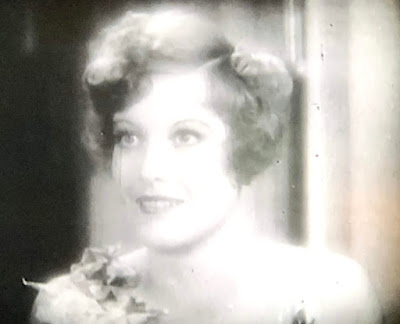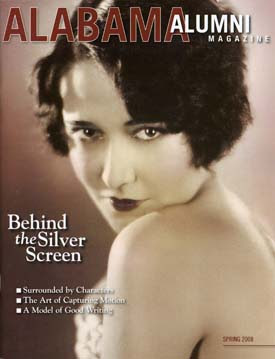This post is another in what has become a series on this blog featuring Johnny Mack Brown. He first became known playing football at the University of Alabama where he was instrumental in the team's unexpected victory over the University of Washington in the 1926 Rose Bowl. He returned to the west coast later that year, made his first film appearance in 1927 and built a long career in Hollywood ranging from silent films into the 1960's. He made dozens of western movies during that time.
I've posted a couple of times on this blog about Brown's movies. In a five-part series I took a deep dive into his 1928 film A Lady of Chance which was partially set in "Winthrop", Alabama. His leading lady was mega star Norma Shearer. A second item looked at Brown through the lens of a film he made, but was never released. Clark Gable replaced him in a new version.
Now it's time to examine one of those westerns. Flame of the West reached theaters on June 25, 1945, and was one of seven Brown films released that year. Here Brown plays an unusual character for western heroes--physician John Poole, who arrives in Trail Forks to set up a practice. He quickly meets Abbie Compton [Lynne Carver] who helps him unpack his office materials, and Add Youman [Raymond Hatton] who is the town's "horse doctor" but seems to spend the rest of the film as Poole's sidekick.
Naturally, all is not well in Trail Forks. The wealthy saloon owner and his allies rule the town and are not concerned with the niceties of law and order. A group of citizens opposed to this situation, including Abbie, her father and Youman, have a meeting to decide a course of action. Poole is put on the spot, declares he'd like to wait and see what happens, and leaves. Everyone assumes he's a coward. The group decides to hire legendary lawman Tom Nightlander [Douglass Dumbrille], who just happens to be an old flame of Poppy Rand [Joan Woodbury], the madam at the saloon.
Earlier in the film Poole tells Youman that he quit carrying his guns because he once killed the wrong man. He keeps the weapons in his medical bag and just uses them for target practice to improve his hand steadiness for surgery. We see an example in one scene when Poole is outside of town doing target practice, and Nightlander rides up on his way to accept his new post. The two engage in some friendly shooting competition and part on good terms.
Nightlander quickly takes charge but cleaning up the town naturally creates some resistance. The saloon owner sets up a trap for Nightlander. Poppy begs him not to walk into it, and Abbie asks Poole to talk him out of it. Poole tells her he can do nothing, since Nightlander is only doing his job.
Further comments are below many of the photos, including some about the film's conclusion.
Being a lifelong fan of film and TV westerns, I found this one very enjoyable. Brown was no great actor, but he played this sort of role well and the 71-minute film moves at a rapid pace.


Under the credits we see a cattle herd, which we soon learn is heading to Trail Forks.
Adele Buffington wrote screenplays in a long career that lasted from 1919 until 1958. She was also a founder of the Screen Writers Guild. She wrote many western scripts, including ten for Johnny Mack Brown's Nevada Mackenzie character that were filmed from 1943 until 1945.
Bennett Foster [1897-1969] was a prolific author of western stories published in both slick and pulp magazines. The source for this film was "Trail Town Fever" that appeared in the February 1943 issue of Star Western. Interestingly, that issue also contains a story by even more prolific Alabama author Tom Roan, "War-Song of the Bullwhip."
Bennett Foster - Star Western February 1943 - Trail Town Fever
Most of the "unknowns" listed in the credits below Lynne Carter were busy actors for decades. Between 1932 and 1953 Tom Quinn [1903-1982] appeared in numerous small film roles, most of them uncredited. Harry Lewis Woods [1889-1968] made almost 250 films between 1923 and 1958, also in small, mostly uncredited roles usually as a villain. I didn't find Raphael Bennett on either Wikipedia or the IMDB. Riley Hill [1914-1993] made appearances in more than 70 films and a dozen television programs. Jack Ingram [1902]1969] made numerous serials and films between 1935 and 1966. Between 1927 and 1958 John Merton [1901-1969] made over 250 films, often as a villain. Jack Rockwell [1890-1947] also appeared in over 250 movies, mostly westerns.

Pee Wee King [1914-2000] was a country music songwriter and musician [accordion, fiddle] who was born in Wisconsin. He is perhaps best remembered today as co-writer of "Tennessee Waltz." He was also an early union member in Nashville, and his band members were, too. His work introduced waltzes, polkas and cowboy songs into country. King was inducted into the Country Music Hall of Fame in 1974.
Lambert Hillyer [1893-1969] was a prolific screenwriter and director from 1917 until 1949. Thus he was working on this film near the end of his career. He directed such genre gems as The Invisible Ray and Dracula's Daughter, as well as the first screen appearance of Batman in a 15-part serial in 1943. Hillyer also directed many silent and sound westerns and returned to direct some episodes of the TV western The Cisco Kid in the early 1950's.
The calm before the storm in Trail Forks in the film's first scene.
The real action begins in the saloon, where Pete and the gang are entertaining a few afternoon patrons.
Madam Poppy Rand hired the band in Center City where she also picked up some new ladies for the saloon. She tells Pete the song they're playing sounds like it came from the undertaker.
Rand was played by Joan Woodbury [1915-1989] who made some 80 films between 1934 and 1964. Most of the titles were B-movies.
After scolding the band, Poppy entertains the saloon crowd with a song of her own.
For some reason Abbie is helping Poole unpack in his new office. Perhaps it's this film's version of "meeting cute". Doc Poole's first case turns out to be delivery of a baby.
I've discussed Lynne Carver in a recent blog post about her first marriage to Birmingham dentist Ralph McClung. A Kentucky native, her film career began with several uncredited roles in 1934 and 1935 and lasted until 1948. During that time she had significant roles in A Christmas Carol, The Adventures of Huckleberry Finn, Calling Dr. Kildare and others. She died of cancer in 1955 at age 38.
Raymond Hatton played Add Youman the horse doctor in this film. Hatton appeared in almost 500 films and many television roles between 1908 and 1967, when he made a brief appearance as an elderly hitchhiker in In Cold Blood.
Poole is caught between the two female leads Poppy and
Abbie here.
Halfway through the film there is a pause in the action to let King and his band entertain the saloon crowd. Each musician has a solo.
I have been unable to identify this young lady, whose impressive yodeling is also featured in the band's number.
Poole shows Youman a few tricks with the gun he doesn't carry.
Poole is confronted at the citizens' committee meeting and does not impress the townspeople.
In the midst of all the trouble brewing in town, Nightlander and Poole have an interesting conversation. Nightlander asks him what he would do for a fella who has cancer. Poole declares he'd cut it out. Their talk doesn't go much further than that, but I guess we are to assume Nightlander has cancer.
Nightlander was played by Douglass Dumbrille [1889-1974]. He was a Canadian actor who appeared in numerous secondary and minor roles in film and television. His first film role came in 1913, his final one in 1964. In his final television appearances he played a judge in two Perry Mason episodes in 1964 and a doctor in an episode of Batman in 1966. Dumbrille also did theatrical work early in his acting career.
Poppy proves she has a heart of gold in this scene. A young cowboy is killed in the saloon, and she takes up a collection of $1000 for his pregnant widow. She asks Poole to give the money to the young woman, and he agrees.
A patient is being brought to Dr. Poole's office. No stretcher was available, I presume. Note the redundancy of "Dr." and "M.D." on the sign.
Abbie and Poole are concerned about Nightlander's fate.
Poppy, who has changed from a Wild West version of the little black dress into this demure one, tries to prevent Nightlander from walking into the trap. Youman observes her technique.
Nightlander has tangled with the Bull Head saloon crowd since his arrival, and now takes an order to close them down. He is shot in the saloon and dies soon after Poole and others carry him to the doctor's office.
After being shot, Nightlander has a few final words.
Uh, oh, it looks like Dr. Poole will be on the payback case!
Abbie watches as the "coward" gets his gun.
Guns are blazing in the saloon where Poole takes care of business and no prisoners.
Now it's time to return to medical practice.
Abbie apologizes for thinking he was a coward.
Once back in his office, Poole is informed by Youman that he's needed. A stagecoach has overturned and several people are injured. Abbie asks if she can go with him. He says, "Why not? You may as well get used to it."
We can assume the two got married and lived happily ever after. Or something.
During the Golden Age of Hollywood Monogram Pictures Corporation made primarily low budget films and operated under that name from 1931 until 1953, when it became known as Allied Artists Pictures Corporation. Monogram was one of the small studios on "Poverty Row" cranking out numerous westerns, crime films comedies and adventure films during that period. You can see the massive list of Monogram/Allied Artist releases from 1931 until 1978 here.













































































